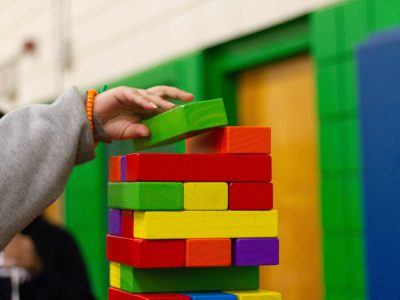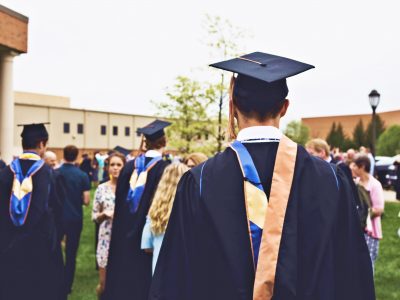Canada offers a great variety of public and private schools that are open to anyone regardless of their citizenship. However, some expenses may be involved.
 Early Education: Nursery Schools and Kindergartens
Early Education: Nursery Schools and Kindergartens
In Canada, children between the ages of 2–3 and 4–5 can attend nursery schools (daycares) that are not mandatory. Options for child care are varied, ranging from nannies, daycare centres, and home daycares.
In most provinces and territories, children can be registered for kindergarten when they are 5 years of age on December 31 in a school year. Kindergarten is a preschool where children are prepared to study at school. Usually, they have one year in kindergarten before Grade 1 of elementary school. Attendance at kindergarten is required in the majority of Canadian regions except for the Prairie provinces. Full-day kindergarten is not mandatory — you can choose to send your child part-time.
Children may attend kindergarten in local elementary schools that can be public or private. There are various types of organizations offering preschool education in Canada, including the following:
- Co-operative schools are non-profit schools where parents work voluntarily as teachers’ aides alongside professional teachers
- Church-affiliated schools are usually attached to religious organizations and may include religious education
- Private schools are for-profit organizations and are usually expensive
- Local public schools offer free education
Admission
Children of all permanent residents of Canada, either Canadian- or foreign-born, have the right to attend kindergarten in a public elementary school for free. Kindergarten registration usually begins in January or February for the following September.
To register your child, you should submit these documents:
- Your child’s birth certificate
- Immigration documents or proof of Canadian citizenship for both you and your child
- Your child’s immunization record
- Proof of your residence address (a purchase or rental agreement, your current year property tax receipt or current month rental receipt)
Fees
Many preschools are private and charge between C$450 and C$1,300 a month or between C$5,400 and C$16,200 a year. Early education in Ontario and British Columbia is more expensive, and in Manitoba, Prince Edward Island, and Quebec, it is rather affordable.
Costs of child care services can vary depending on the city. Montreal is one of the most affordable Canadian cities to raise children: in this city, child-care services cost 10 times less on average compared to Toronto and other major cities in Canada. For instance, the average monthly cost of raising a child in Montreal stands at C$175, at C$650 in Winnipeg, and at C$740 in Charlottetown (Prince Edward Island), while in Toronto this figure amounts to C$1,675. Quebec is more affordable because it has a universal child-care program that has been effective for more than 20 years.
If your child attends kindergarten in the public elementary school, there are normally no fees. However, you may need to pay for school supplies, lunches, and trips.
Activities and Schedule
Children in Canadian kindergartens are prepared to study in elementary school and receive basic skills related to literacy, numeracy, socialization, and creativity. In kindergarten, children acquire the following skills:
- Early literacy and numeracy: learning to write, doing basic math, learning to think critically
- Citizenship and identity: developing as a citizen, through a sense of personal connectedness to their class and school
- Environment and community awareness: understanding their connections as part of a community and the natural world
- Personal and social responsibility: learning to think for themselves, assessing the consequences of their actions, understanding their feelings and those around them, respecting differences in others
- Physical skills: playing and developing motor skills
- Creative expression and creative thinking
Main activities include reading, math lessons, handwriting, and playing to learn. Children also have outdoor and rest time.
A full-day kindergarten can start as early as 7:30 AM and may be open until 6:00 PM. Kindergartens operate from Monday to Friday, from September to June. There are also kindergarten summer camps in July and August.
 Elementary and Secondary Schools
Elementary and Secondary Schools
The next steps of education after kindergarten are elementary and secondary schools. Schools in Canada can be public, private or independent, English or French:
- Public schools are free government-financed organizations
- Private schools are paid for-profit organizations that do not receive public funding. Some of them are religious-based, and they can be day schools or boarding schools, coed, boys or girls schools
- Independent schools are private schools that are accountable to a board of governors or trustees
- English or French schools: education can be offered in English or French across the country, even in areas where one language is more commonly spoken than the other. In Quebec, the children of immigrants are typically required to attend public schools in French. However, private schooling options in English may be available
School Grades
It takes 12 years (11 in Quebec) for children to receive elementary and secondary education in Canada. School education includes two or three levels:
- Elementary (primary) school normally runs from grades 1 to 6 (or from 1 to 3 if there is a middle school). In most provinces and territories, it also includes kindergarten. In Ontario, elementary schools include 2 years of kindergarten — Junior Kindergarten (JK) and Senior Kindergarten (SK)
- Middle school (junior high school) is offered in most provinces. Middle school typically runs from grades 6–7 to 8–9 (age 12–15). In Ontario, it normally only includes grades 7 and 8
- Secondary school (high school) normally runs from grades 9–10 to 11–12. It ends in grade 12 in all provinces except Quebec where after grade 11 students proceed to a pre-college program such as CEGEP (Collège d’enseignement général et professionnel)
In most provinces and territories, children must start school in a year when they are 6 or 7 years of age on December 31 and attend school until they rich the age of 16 or 18 (depending on the province or territory).
Age ranges of compulsory education across Canadian provinces and territories are the following:
- Alberta, British Columbia, Newfoundland, Quebec, Yukon: from 6 to 16
- New Brunswick, the Northwest Territories: from 5 to 18
- Nova Scotia, Prince Edward Island: from 5 to 16
- Manitoba: from 7 to 18
- Ontario: from 6 to 18
- Saskatchewan: from 7 to 16
Admission
You may be able to choose the school for your children. To enroll your child in elementary or high school, contact your local school board — it is recommended to do it well before the school year begins.
To apply for admission to a school, it is required to have:
- Completed application forms
- Child’s birth certificate
- Immigration documents or proof of Canadian citizenship for parents and child
- Details of child’s medical history including immunization record
- Proof of residence address (a purchase or rental agreement, current year property tax receipt or current month rental receipt)
- School results from your home country or previous school in Canada. The child is required to have finished certain grades that correspond to grade levels in Canada (if you immigrate from another country). He also must have proficient skills in English or French
- Non-refundable application fee (in private schools)
- Test scores (depending on the school, it may be necessary for your child to pass an entrance exam)
Many Canadian public schools accept international students who can choose to study in English, French or both languages. The school may offer free language courses before your child begins classes. In Manitoba, enrolment of international students is limited to 20% of total school enrolment in any school in a given year.
The admissions process in prestigious private schools usually begins long before the child reaches school age (sometimes right after he is born).
Fees
Public schools in Canada are free. But there may be fees for school supplies and fees for your child to participate in extra activities. Public schools are allowed to charge parents with the following fees:
- Schools supplies (pencils, pens, markers, pencil cases, paper, exercise books, folders, scissors, glue, geometry sets, and gym clothing)
- Costs associated with extra courses and programs (theatre, photography, aquaculture, web design, etc.)
- Extracurricular activities, field trips
- School clothing, school photos
- Rental of musical instruments
Also, many public schools charge international students (non-residents) fees. Annual costs can range from approximately C$8K to C$14K.
Private schools in Canada charge fees, and it concerns both international and local students. Minimum annual tuition can be under C$2,500 and maximum can reach C$70,000 or even more. Among the most expensive private schools are St. Michaels University School (Victoria), Brentwood College School (Mill Bay), St. George’s School (Vancouver), Applewood Academy for Progressive Learning (Belleville), and Appleby College (Oakville).
Programs and Schedule
In Canada, the education year usually begins in early September and ends in late June, with about two months off during the summer and two holiday sessions at Christmas time (late December) and Easter (April). The school year is divided into periods (quarters, terms or semesters).
Schools run from Monday to Friday. The school day in elementary schools is typically from 8:30 AM to 3:00 or 3:30 PM, with a one-hour lunch break. There are also two 15-minute breaks. In high schools, hours are normally from 8:30 AM to 2:30 PM. Extracurricular activities and sports are scheduled after school hours.
There can be English and French programs in Canadian schools (depending on the province or territory). School subjects include Arts, Business Education, Career and Technical Education, Information Technology, English, French, Health, Mathematics, Physical Education, Science, Social Studies, and many others depending on the school.
Around grade 9, students receive career guidance counselling and select subjects that will be useful in their chosen career. Larger schools may offer specific levels, for instance, academic (sciences, higher mathematics, advanced languages), vocational (agricultural education, business education, economics, medical care), and general levels.
High school students get a high school diploma which allows being admitted to a Canadian university. Another way to get high school equivalency is to pass the General Educational Development (GED) exam test.
 Post-Secondary Education
Post-Secondary Education
If you made up your mind about studying in Canada, make sure you apply several months in advance for a post-secondary program at a university or college. To do so, you need to take 4 steps. Read more about Post-Secondary Education in Canada →
